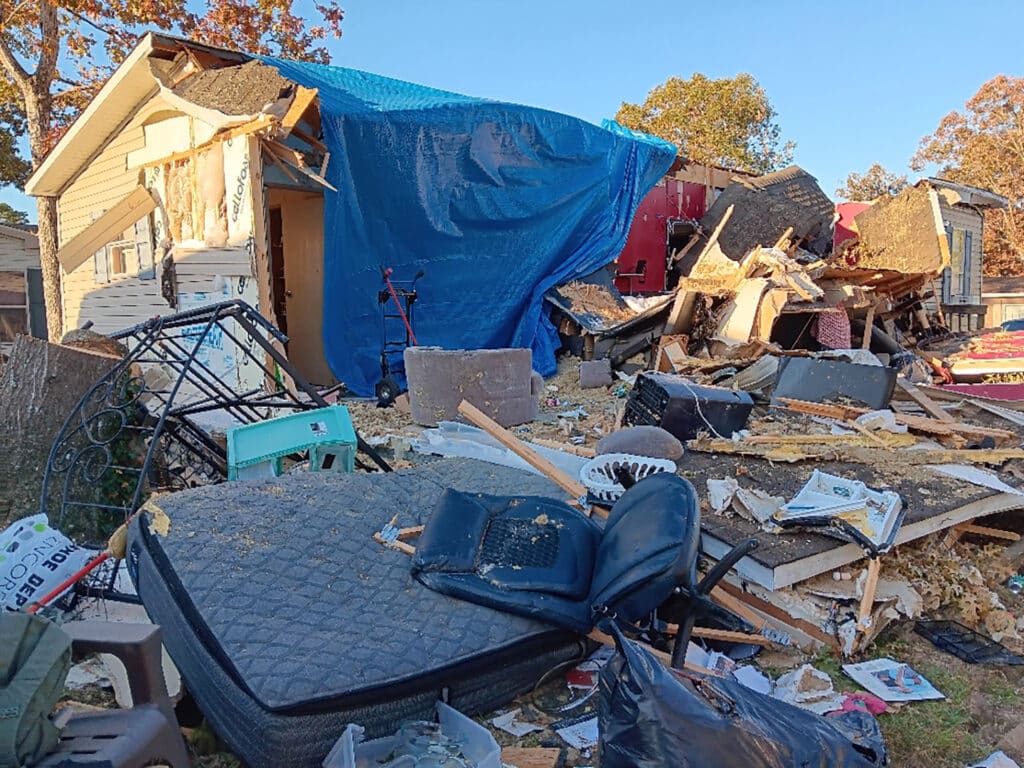CEBU, Philippines—Super Typhoon Haiyan made its initial landfall Nov. 7 in Guiuan, Eastern Samar, with maximum sustained winds of 235 kilometers per hour. Flash floods, landslides and wind damage were reported in the Eastern Samar and Leyte provinces. Telecommunication and electricity services remain interrupted. Air and seaports are closed. Initial needs assessments have prioritized shelter, food and health concerns.
Texan Mark Moses, a Southern Baptist representative, had returned to Panay Island in September following a year-long stateside assignment, just in time to be available to assess the damage on behalf of Baptist Global Relief in a country he knew well from over 25 years of ministry.
Southern Baptists of Texas Convention Disaster Relief workers serving on the Rapid Assistance Team were deployed immediately to Cebu, Philippines. Additional volunteers from SBTC churches departed for Roxas City, Philippines, Dec. 6. This ministry team will serve with local churches, Filipino nationals and personnel from Baptist Global Response to assist in rebuilding a local school and aiding families in the communities.
SBTC DR staff will schedule more teams to respond as soon as needs are identified and the logistics coordinated.
In the meantime, although social media and news programs around the world are filled with images of relief teams making their entrances into Filipino communities devastated by Typhoon Haiyan, hundreds more villages in extremely isolated areas have yet to see any relief vehicles at all.
These villages are tucked away in northern Cebu’s rolling hills, down winding, bumping roads barely wide enough for vehicles to traverse. They are the kinds of villages sought out by Southern Baptist relief efforts.
Several weeks after the storm, the recovery task in the cities and towns is monumental and millions of dollars in relief aid is flowing into those efforts. Many smaller communities, however, must fend for themselves.
People in out of the way areas often are neglected for one to two weeks in the aftermath of a major disaster, said Larry Shine, a member of the four-man BGR rapid assistance team sent to Cebu Island and recently returned to the U.S. The team’s goal was to go into areas not highlighted in the media and partner with local pastors to bring effective aid to neglected communities.
Shine, pastor of Pine Forest Baptist Church in Onalaska, and Scottie Stice, pastor of Southwest Texas Cowboy Church in Uvalde, traveled Nov. 16 to the ministry area of Filipino pastor Nabanglo Driz.
First visitors
They were the first people to visit three mountain villages after the typhoon. On a rural road, their van passed a sign tacked to a post that read “Help Us.”
The houses in this area are perched on hilltops, meaning they were more exposed to Typhoon Haiyan’s ferocious winds. People in these villages are still living in their collapsed homes. One family with a 1-month-old baby is trying to shelter in a badly damaged hut not even tall enough for someone to kneel in.
To get relief supplies, the villagers must hike out to the main road and hand-carry the goods back down winding, bumpy paths.
In one village the team visited, the five concrete houses of Leonilo Liquigan and his extended family look as if a wrecking ball came through. Liquigan said people in the village came to his home because it was concrete and stronger, but even his concrete home couldn’t withstand the storm.
He said he knew they needed to leave the area, but they had nowhere to go.
Since his village has been without electricity, Liquigan said he’s cooked coconuts and taken the oil and inserted a wick to make candles. Shine held Liquigan’s hand and prayed a blessing over him, asking God to “bring order where there is chaos.”
Survivor with a scar
In the village of Kapilya, 5-year-old John Carl Ulila played with a plastic lid, a metal bolt and a rock. He does not have any toys. He is a survivor, but one who will forever bear a scar.
During the typhoon, a flying piece of corrugated tin hit Ulila and cut his nose and cheek—coming dangerously close to his eye. His mother took him to a medical clinic but was referred to a more expensive clinic his family could not afford.
They came home without any medicine.
Stice noticed Ulila’s eye when he arrived at his home. He gave Ulila’s mother antibiotic cream to treat the wound.
Driz identified Kapilya as one of the neediest villages out of the nine he serves. There are 30 families in Kapilya, where a house church meets each week for worship. The gazebo they meet in was destroyed by the storm.
The closest water reservoir to Kapilya is 11 miles away. The village’s water system operates off of a pump and because the electricity is out, the water is too. Right now, Ulila’s mom says they are collecting rainwater to drink. Stice and Shine discussed having a pump station to help bring water closer.
Later that day, Shine, Stice and Driz discussed how to handle aid relief and sharing the gospel with women in the area who aren’t as open. “The best ministry is to come build the house, share with her and tell her why you came and built the house,” Shine told Driz.
Driz believes this distribution project will open doors to the community. Many people close their hearts when they see him approach with a Bible, Driz said. Showing Christ’s love by helping the hurting is a bridge to sharing the gospel.
“With this project, I believe there will be more fruit,” Driz said.
Cowboys and pastors
Over a dinner of rice and vegetables, Shine showed Driz photos of his guns and the deer he has shot in the backyard of his East Texas home. Stice showed pictures of his horses on his West Texas ranch. Driz talked about one of his favorite TV shows—Rambo—and how he enjoys detective movies because of the suspense. The men talked about what fish the U.S. and the Philippines have in common.
For the evening, they were just men —talking about hunting and movies.
Later that evening, Driz, Stice and Shine sat down and continued their discussion about the areas they visited. Shine asked questions to help Driz to think through the rebuilding process and what resources they would need.
He encouraged Driz to use Filipino church members to deliver the relief supplies.
“By using an existing network, it is more effective,” Shine said. “The church is the best network in the world.”
Filipino churches know the people and the culture—and will be there after all the international aid workers and media have left, Shine said.
“What Western churches can do is provide the financial aid resources he [Driz] doesn’t have,” Shine said.
Shine encouraged Driz and his church to train others and then encourage them to pass the knowledge on—an approach to humanitarian aid that facilitates church planting.
The discussion then moved to what to include in relief kits—items every Filipino family must have in their kitchen to survive—and how best to transport the goods. Shine asked Driz to make himself available to minister to the families while others of his team are distributing supplies.
Driz, Stice and Shine formulated a plan for aid relief and packets to be delivered the following week. BGR will purchase supplies for the relief packages with funds donated by supporters in the United States and elsewhere.
“We have full confidence in your ability to do this,” Shine told Driz.
To donate visit sbtexas.com/DR.














